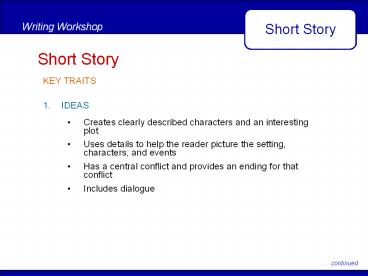Short Story - PowerPoint PPT Presentation
1 / 14
Title:
Short Story
Description:
... Short Story KEY TRAITS ORGANIZATION Follows a clear sequence of events VOICE Has a consistent point of view Uses the active voice WORD CHOICE ... passive voice. – PowerPoint PPT presentation
Number of Views:170
Avg rating:3.0/5.0
Title: Short Story
1
Short Story
KEY TRAITS
- IDEAS
- Creates clearly described characters and an
interesting plot - Uses details to help the reader picture the
setting, characters, and events - Has a central conflict and provides an ending for
that conflict - Includes dialogue
. . .continued
2
Short Story
KEY TRAITS
- ORGANIZATION
- Follows a clear sequence of events
- VOICE
- Has a consistent point of view
- Uses the active voice
- WORD CHOICE
- Uses sensory language
. . .continued
3
Short Story
KEY TRAITS
- SENTENCE FLUENCY
- Varies sentence beginnings
- CONVENTIONS
- Uses correct grammar, spelling, and punctuation
. . .continued
4
Prewriting
What Should I Do?
What Does It Look Like?
See page 164 What If Questions
. . .continued
5
Prewriting
What Should I Do?
What Does It Look Like?
2. Figure out what happens. Jot down some ideas
for the characters, setting, and plot of your
story. Use a chart like this one to keep track of
your thoughts.
. . .continued
6
Prewriting
What Should I Do?
What Does It Look Like?
3. Map your story. Think through the plot before
you start writing. Then make a flow chart like
the one shown here. If you prefer, you can make
an outline or a list of events instead of a flow
chart.
TIP Is it hard to come up with a great plot?
Dont worry about making it perfect now. More
ideas may come to you as you write, and you can
always change plot details later.
. . .continued
7
Drafting
What Should I Do?
What Does It Look Like?
1. Come up with a creative beginning. Capture
your readers interest right away. You can use
sensory details to introduce the setting or the
characters, or you can start out with dialogue.
. . .continued
8
Drafting
What Should I Do?
What Does It Look Like?
2. Decide on a point of view. A character in your
story can tell the story using I. This kind of
first-person narrator draws your readers in. A
third-person narrator is outside the story and
refers to characters as she, he, and they. This
type of narrator gives a broad view of characters
and events.
TIP Either point of view is fine. Just be sure
to stick to one or the other.
. . .continued
9
Drafting
What Should I Do?
What Does It Look Like?
3. Make the order of events clear. Use words and
phrases that tell your reader when things
happened and how much time passed.
. . .continued
10
Drafting
What Should I Do?
What Does It Look Like?
4. Solve the central conflict. A conflict is a
problem to solve. If you dont have a conflict,
you dont have a story. Remember that the storys
ending must show how the conflict is resolved.
TIP Before revising, consult the key traits on
page 158 and the criteria and peer-reader
questions on page 164.
. . .continued
11
Revising and Editing
What Should I Do?
What Does It Look Like?
. . .continued
12
Revising and Editing
What Should I Do?
What Does It Look Like?
See page 164 Ask a Peer Reader
. . .continued
13
Revising and Editing
What Should I Do?
What Does It Look Like?
. . .continued
14
Revising and Editing
What Should I Do?
What Does It Look Like?

